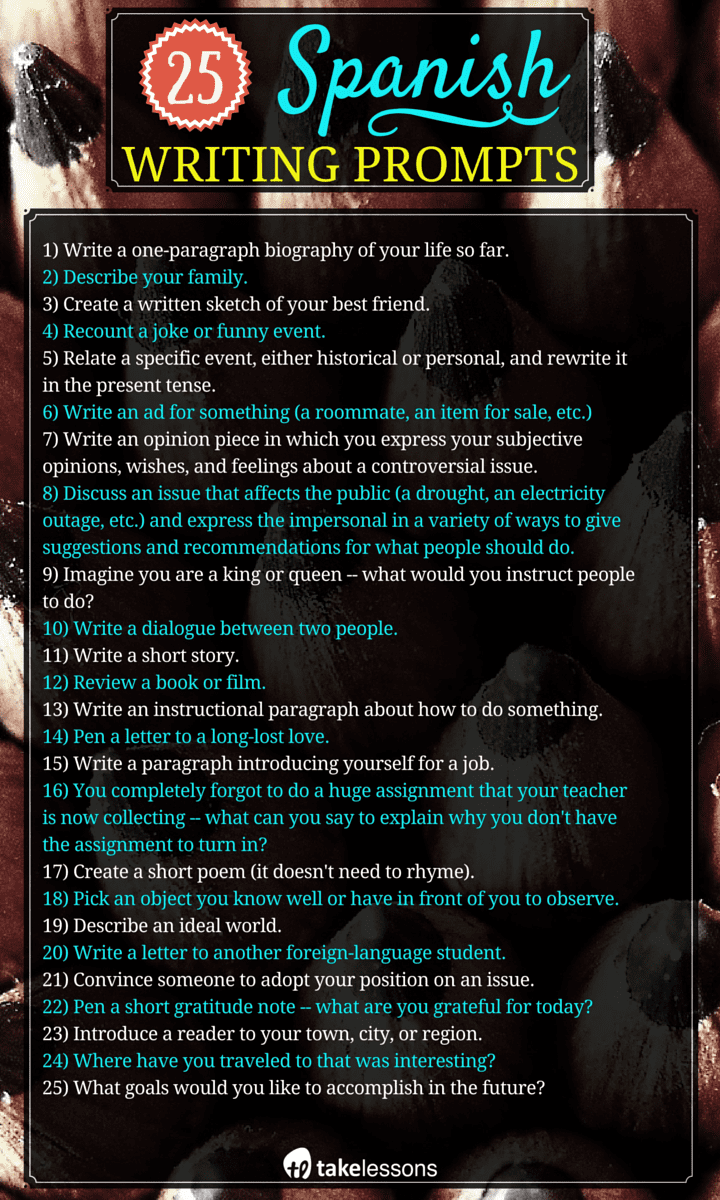Are you interested in discovering some new Spanish writing prompts? This post will give you some fun, creative writing prompts in Spanish that can be used in the classroom, at home, and as you work toward becoming a more fluent writer and speaker of the Spanish language.
Learning a new language is an exciting journey. Unfortunately, it’s not something you can master overnight. Becoming fluent in a language like Spanish takes time, practice, and dedication. Once you learn something new, you must continue to use it in order to put it to memory.
How Can I Practice My Spanish Writing?
If you’re trying to develop better writing in Spanish, it goes without saying that writing is the best way to do so.
Here are some other tips that can help you master this language:
- Take lessons with a Spanish tutor, either online or in-person
- Reading – read constantly and never stop reading!
- Make Spanish writing prompts part of your daily routine – consistency is key
- Don’t try to impress – just get some words out on paper!
- Learn proper punctuation, spelling, and grammar
- Find a buddy – practice makes perfect but it’s even better if you have a friend to help you learn
To improve your Spanish, it’s important to apply the concepts you’re learning directly in practice. You can do this by working on writing prompts for Spanish class, of course, but also through daily conversation and other forms of practice.
You can learn about more best practices for learning Spanish (as well as other languages) in this video:
Writing is an especially helpful way to practice Spanish, since you can develop and practice specific grammatical structures. Writing also encourages you to explore new vocabulary, work on your spelling, and combine all the concepts you’ve learned thus far. And the best part? You can always ask for feedback from a native speaker, your tutor, or a teacher.
What Are Some Good Writing Prompts? 25 Best Spanish Writing Prompts
Whether you are interested in finding writing prompts for Spanish class or for some extracurricular practice, we have you covered. Below, we have provided a handy list of Spanish writing prompts to help you challenge yourself and put to use what you already know.
The Spanish writing prompts below all address specific concepts that are crucial to expressing yourself fully and correctly. We have listed 25 Spanish essay ideas in our infographic and included a few bonus exercises for extra practice. Even though there are many fun ways to learn Spanish, this exercise is very hands-on and your progress will be noticeable.
So grab a pen and paper, and let’s get started!
1) Write a one-paragraph biography of your life so far. This can include a variety of past tenses to describe habitual and one-time actions, as well as tenses to describe events that happened before or after another event. You can also practice using sequencing and transition words such as primero, después, and entonces.
2) Describe your family. Not only will you be using family-related vocabulary, you’ll also get practice describing age and occupation.
3) Create a written sketch of your best friend. This Spanish essay idea encourages you to detail why you like him or her, and also make use of physical and personality descriptors (alto, rubio, amable, cómico). You can also explain how you met using the reciprocal verb conocerse.
4) Recount a joke or funny event. This will challenge you to correctly use colloquial expressions as well as unique vocabulary that will take you outside of the box of typical Spanish vocabulary. This Spanish writing prompt will also help you experiment with puns and wordplay in Spanish and challenge you to make a joke transcend two languages.
5) Relate a specific event, either historical or personal, that occurred. Then rewrite it in the present tense. Bonus points if you rewrite it again in the future tense or the plus perfect tense! This exercise will help you to become faster and more accurate at conjugating verbs in any tense. The more you practice it, the more changing between tenses will become second nature to you.
6) Write an ad for something (a roommate, an item for sale, etc.). This will help you practice describing cost and specific details (for example, size or shape), as well as expressing requirements and commands in a polite way.
7) Write an opinion piece in which you express your subjective opinions, wishes, and feelings about a controversial issue. This will allow you to practice using the subjunctive mood (when necessary).
8) Discuss an issue that affects the public (a drought, an electricity outage, etc.) and express the impersonal in a variety of ways to give suggestions and recommendations for what people should do (for example, “Hay que comunicar con el gobierno si…“).
9) Imagine you are a king or queen — what would you instruct people to do? Use command forms (for example, “Traiga la comida.”) to order others to fulfill your wishes.
10) Write a dialogue between two people. Use question words to form interrogative sentences, and make sure the other person responds with the appropriate verb form (for example, if the question refers to “you all,” the response to use is “we.”).
11) Write a short story. Try to make it as descriptive as possible while also including lots of action verbs to move the story along. Have fun with it; it can be a crazy story with a creative twist or unexpected angle! You’ll certainly improve your Spanish reading comprehension if you write enough of these!
12) Review a book or film. Take a stance and then justify your reasoning, using connecting words like además, pero, etc.
13) Write an instructional paragraph about how to do something (arrive at a certain location using the bus, cook a particular dish, etc.). Tailor the formality of your words to your intended audience.
14) Write a letter in Spanish to a long-lost love. What would you say to this person to express your anguish, your delight, your memories, and your regrets? Use diminutives to express your affection for the person.
15) Write a paragraph introducing yourself for a job. Describe your education, skills, motivations, and interests. What makes you a good fit for this job?
16) You completely forgot to do a huge assignment that your teacher is now collecting — what can you say to explain why you don’t have the assignment to turn in? What compromise can you request in order to not receive a failing grade?
17) Create a short poem — it doesn’t need to rhyme. Try reading a few poems (check out Pablo Neruda, for example) to find inspiration.
18) Pick an object you know well or have in front of you to observe, then describe the item as fully and descriptively as you can. You can use comparisons (tan … como) and superlatives (el más…).
19) Describe an ideal world (for example, “No habrá.”). This is another opportunity to use the future tense.
20) Write a letter to another foreign-language student. In the format of a pen pal letter, explain what you like about learning Spanish, what you find difficult, what you hope to use Spanish for, and why you decided to learn a foreign language.
21) Convince someone to adopt your position on an issue. Use persuasive language (en mi opinión es necesario….) to convince them of the strengths of your argument and the weaknesses of theirs. You can choose a political topic, a personal decision, or anything else that can be argued for or against.
22) Write a short gratitude note — what are you grateful for today? Express your thanks with words of appreciation.
23) Introduce a reader to your town, city, or region — what’s particularly unique and interesting about it? Aim for the style of language you find in guide books and travel section articles.
24) Where have you traveled to that was interesting? Describe your trip, your travel partners, your activities, and your experience of this new place.
25) What goals would you like to accomplish in the future? If you could do anything, what would you do?
Share this Image On Your Site
4 Bonus Creative Writing Prompts in Spanish
Are you looking for a few more free Spanish writing exercises? We’ve included some bonus exercises below. Add these to your daily Spanish writing practice and prepare to see your skills improve in no time.
- Write about a time you overcame a challenge. Describe the obstacle and how it made you feel. Express how you felt when you faced your fears and conquered them. Did you feel strong, proud, or accomplished? Use descriptive adjectives and phrases to bring this experience to life.
- Think about your favorite character in a book or movie, and then write his or her back story. Where are they from, and what was their childhood like? What were the events that led to their role in the story you love? This is a great opportunity to practice past and future tenses.
- Describe an everyday task, like making a sandwich, as if you were explaining it to an alien from another planet. For this Spanish writing prompt, go into great detail, describing each aspect, from what bread is to how to spread the mayo. Remember, an alien won’t be familiar with a refrigerator, cupboard, or even a butter knife!
- Write out the recipe for your favorite meal. This Spanish essay writing not only encourages you to practice vocabulary for food and ingredients, but you will also need to use the command form of verbs.
Try to practice writing one prompt each day or each week; by committing to a specific schedule you’ll make substantial and long-lasting progress as you learn how to speak Spanish. You can also respond to a prompt, go back at a later date, reread what you’ve written, and edit it based on your more advanced knowledge of vocabulary and grammar.
Alternatively, you can also respond again to a prompt without rereading your original copy first, and then compare to see how your Spanish has changed.
Is Spanish Easy to Write?
Spanish is not the most difficult language to write, but it does take some practice to get proficient! Consider starting with basic writing prompts and then work yourself up to advanced Spanish writing prompts as you gain confidence.
Interested in even more guidance? Sign up for online Spanish lessons to work with a private tutor one-on-one. Your instructor can provide you with more Spanish writing practice in a Spanish writing class and will review and offer feedback on all your essays.
Above all, enjoy using these prompts as a creative way to find your voice, en español!
Want more help with beginner or intermediate Spanish? Check out our FREE classes — live and online through the TakeLessons classroom! Learn more here.
 Post Author: Joan B.
Post Author: Joan B.Joan B. lives in Carmichael, CA and has been teaching high school Spanish for more than 18 years. A lover of language, she’s studied French, Arabic, and Italian and spent time living in Spain. Joan aims to help students improve on tests and increase their conversational ability when traveling to Spanish-speaking countries. Learn more about Joan here!
Suzy S.






